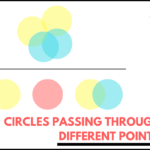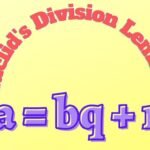Question 1) What is Area?
Answer – The measurement of the surface enclosed by a closed figure is called Area. The area is measured in the square unit.
Question 2) Prove that the area of the triangle is half of the area of a parallelogram if they both are made on the same base and between the same parallel lines.
Answer –

Let △ABC and parallelogram ABCD be on the same base AB and between the same parallel lines AB and CD.
We have to prove ar(△ABC) = ½ ar(ABCD)
We extend the side CD to point E and Join BE to obtain another parallelogram ABEC.
Now, parallelograms ABCD and ABEC are made on the same base AB and between the same parallel lines AB and ED so their area will be equal.
Therefore, ar(ABCD) = ar(ABEC) ………………….(1)
The parallelogram ABEC is divided into two triangles △ABC and △BEC by diagonal BC. Now, in △ABC and △BEC.
AB = EC (Opposite sides are equal in parallelogram)
BE =AC (Opposite sides are equal in parallelogram)
BC = BC (Common side in both triangles)
By SSS rule, △ABC ≅ △BEC
Therefore, ar(△ABC) = ar(△BEC) ………………….(2)
But ar(△ABC) = ½ ar (ABEC) ………………….(3) [From equation (2)]
From equations (1) and (3),
ar(△ABC) = ½ ar (ABCD) Hence Proved.
Question 3) Show that a median of a triangle divides it into two triangles of equal areas.
Answer –

Let PQR be a triangle and PS be its median.
So, S will be the midpoint of QR and QS = SR.
We have to prove that ar(△PQS) = ar(△PRS).
We draw PM ⊥ QR to get the height of both triangles.
Now, ar(△PQS) = ½ × base × height
= ½ × QS × PM
= ½ × SR × PM [⸪ QS = SR] ………..(1)
ar(△PRS) = ½ × base × height
= ½ × SR × PM …………….(2)
From equations (1) and (2),
ar(△PQS) = ar(△PRS) Hence Proved.
Question 4) What is the area of a triangle in coordinate geometry?
Ans. – In coordinate geometry, if a triangle ABC is given and the coordinates of its vertices are A(x1, y1), B(x2, y2), and C(x3, y3). Then
Area of triangle ABC = ½[x1(y2 – y3) + x2(y3 – y1) + x3(y1 – y2)]
Question 5) When is the area of the triangle maximum?
Ans. – We know the area of a triangle if its height and base are given.
Area of triangle = 1/2×Base×Height or (Base×Height)/2
When the measurement of base and height is maximum then the area will be maximum. In this condition, the triangle is a right-angled triangle.
Question 6) What is the area of triangle ABC?
Ans. – The area of triangle ABC when all three sides are given. We use Heron’s formula to find the area of a triangle.
Area of the triangle by Heron’s formula = √s(s – a)(s – b)(s – c)
Where, s = semi-perimeter of a given triangle ABC
a, b, and c = three sides of the triangle, a = side BC, b = side AC, and c = side AB
The area of a triangle when its height and base are given.
Area of triangle = 1/2×Base×Height or (Base×Height)/2
Question 7) Can the area of the triangle be negative?
Ans. – The area of a triangle can never be negative because the area is a positive quantity. In coordinate geometry, sometimes we get the value of the area negative but the negative sign shows the direction of the vertices of the triangle, not the negative area.
Question 8) Can the area of the triangle be zero?
Ans. – Generally, the area of a triangle cannot be zero if the triangle is already made. But in coordinate geometry, if three points are given and we have to find the area of the triangle made by the given three points. We find the area of that triangle using the formula and if we get the area 0. In this condition, the given three points do not make any triangle because they lie on a straight line. These three points are said to be Collinear points.
Question 9) Can the area of the triangle be negative in coordinate geometry?
Ans. – The area of a triangle cannot be negative in coordinate geometry. If we get the negative area in coordinate geometry the negative sign shows the direction of the vertices of the triangle, not the negative area.
Question 10) Can you find the area of a triangle?
Ans. – Yes, we can find the area of a triangle with the help of Heron’s formula or base-height formula.
Question 11) What does the area of a triangle mean?
Ans. – The meaning of the area of a triangle is the part covered by three closed line segments.
Question 12) Can the area of a triangle be smaller than the perimeter?
Ans. – As we know that area and perimeter are two different measurements. The area is measured in square units and the perimeter is measured in distance units. Therefore, technically we cannot compare both. If we compare both numerically then it is possible that the area can be smaller than the perimeter.
Question 13) Can the area of a triangle be a decimal?
Ans. – Yes, the area of a triangle can be found in decimal.




















































































































































